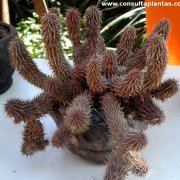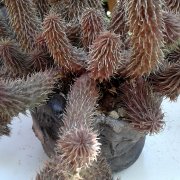Care of the succulent plant Huernia pillansii or Cocklebur |
|
The genus Huernia, family Apocynaceae, comprises 60 species of succulent plants native to East Africa. Some species are: Huernia pillansii, Huernia macrocarpa, Huernia zebrina, Huernia guttata, Huernia aspera. Common names: Cocklebur, Cockle burrs. This species is native to Cape Province, South Africa. They are small, highly branched, slow-growing succulent plants that reach 12 cm (4.7") in height. The stems have 20 ribs with conical tubercles on the margins; rudimentary hair-like leaves sprout on them and dry with age. Some stems can develop roots (great for making cuttings). The curious flowers are shaped like a starfish and can be yellow, cream, red or brown. If they bloom, they do so in summer. Cocklebur is used in pots as indoor plants, for balconies, terraces, greenhouses and in rockery. Huernia pillansii prefers a semi-shade exposure avoiding direct sun in the central hours of the day. It resists well the heat of the Mediterranean summer but not the cold below 4 ºC (39.2 ºF). The soil can be a mixture of equal parts coarse sand and leaf mulch or a commercial cactus substrate with 20% coarse sand. The transplant does every 3-4 years (in spring) if the pot is too small. Water moderately, waiting a couple of days after the substrate has dried. The stems tend to wrinkle when the plant needs water. Cockle burrs does not need fertilizers. Prune branches that have dried out. Huernia pillansii is sensitive to the attack of aphids and mealybugs; monitor excess moisture to avoid fungal diseases. Cocklebur propagates by rooting previously dried branches for a day in a dry and shady place. The seeds germinate very fast but the seedlings grow slowly. |
Images of the succulent plant Huernia pillansii or Cocklebur |
Find plants
Huernia pillansii or Cocklebur | Care and Growing
© 2026 FavThemes

